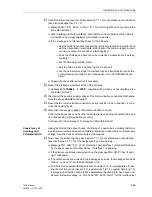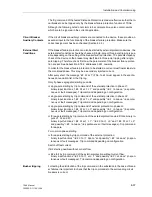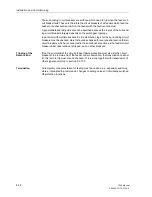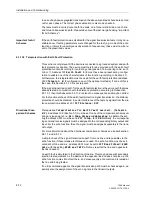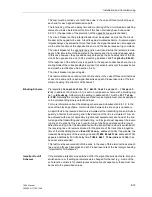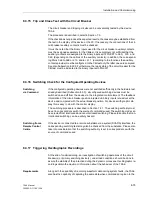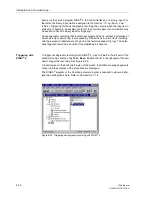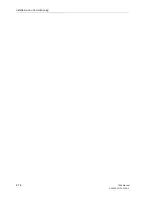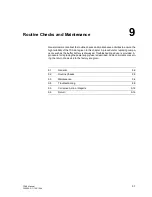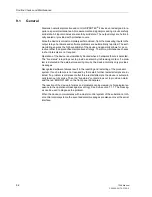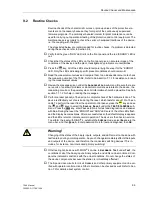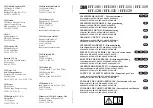
Installation and Commissioning
8-69
7SA6 Manual
C53000-G1176-C156-2
8.3.13 Testing of the Teleprotection System
If the device is intended to operate with teleprotection, all devices used for the trans-
mission of the signals must initially be commissioned according to the corresponding
instructions.
8.3.13.1 Teleprotection with Distance Protection
For the functional check of the signal transmission, the earth fault protection should be
disabled, to avoid signals from this protection influencing the tests: address
3101
FCT EarthFltO/C
=
OFF
.
Pilot Wire
Comparison
The operating mode “pilot wire comparison” differs considerably from other teleprotec-
tion systems as far as the type of transmission (DC closed circuit-loop) is concerned.
The examination is described in the following. If another teleprotection system is used,
this part can be ignored.
Detailed information on the function of the pilot-wire comparison is available in Sub-
subsection 6.6.1.8.
For
Teleprotection for Distance prot. (Teleprot. Dist.)
set
Pilot
Wire Comparison
in Address
121
(Section 5.1). Furthermore, the
FCT Telep.
Dis.
must be set to
Enabled
in Address
2101
. The protection relays at both line
ends must be operating. First the quiescent current loop of the pilot wire comparison
is not supplied with auxiliary voltage.
A fault is simulated outside of zone Z1, but within zone Z1B. Since stage Z1B is
blocked, the Distance Protection is only tripped in a higher-leveled zone (usually with
T2). This check must be carried out at both line ends.
The direct voltage for the quiescent current loop of the pilot wire comparison is
switched to the line. The loop is then fed with quiescent current.
At one line end a fault is simulated outside of the first zone, but within the overreach
zone Z1B. The command is tripped to T1B. This check must be carried out at both line
ends.
Since the quiescent current loop is part of the nature of the pilot wire comparison,
these tests also check if the transmission process is performed correctly. All further
tests described in Subsubsection 8.3.13.1 can be passed over. However, please refer
to the last margin heading “Important for All Schemes”!
Reverse
Interlocking
The checking of the reverse interlocking is described below. If a different transmission
scheme is applied, this part can be skipped.
For more detailed information about the reverse interlocking see Subsubsection
6.4.1.9.
For
Teleprotection for Distance prot. (Teleprot. Dist.)
set
Re-
verse Interlocking
in Address
121
(Subsection 5.1). Furthermore the
FCT Te-
lep. E/F
must be set to
enabled
in Address
2101
. The Distance Protection of the
infeed and switchgears of all outgoing feeders must operate. At the beginning no aux-
iliary voltage is fed to the line for the reverse interlocking.
The following paragraphs describe the testing in a blocked state, i.e. the pick-up sig-
nals of the outgoing devices are connected in parallel and block the tested device of
Summary of Contents for siprotec 7SA6
Page 2: ...Siemens Aktiengesellschaft Book No C53000 G1176 C156 2 ...
Page 18: ...xviii 7SA6 Manual C53000 G1176 C156 2 ...
Page 32: ...Introduction 1 14 7SA6 Manual C53000 G1176 C156 2 ...
Page 82: ...Hardware and Connections 2 50 7SA6 Manual C53000 G1176 C156 2 ...
Page 119: ...SIPROTEC 4 Devices 4 25 7SA6 Manual C53000 G1176 C156 2 Figure 4 20 CFC Logic example ...
Page 190: ...Configuration 5 62 7SA6 Manual C53000 G1176 C156 2 ...
Page 652: ...Installation and Commissioning 8 78 7SA6 Manual C53000 G1176 C156 2 ...
Page 724: ...Technical Data 10 56 7SA6 Manual C53000 G1176 C156 ...
Page 800: ...Appendix A 76 7SA6 Manual C53000 G1176 C156 2 ...
Page 866: ...Appendix B 66 7SA6 Manual C53000 G1176 C156 2 ...

